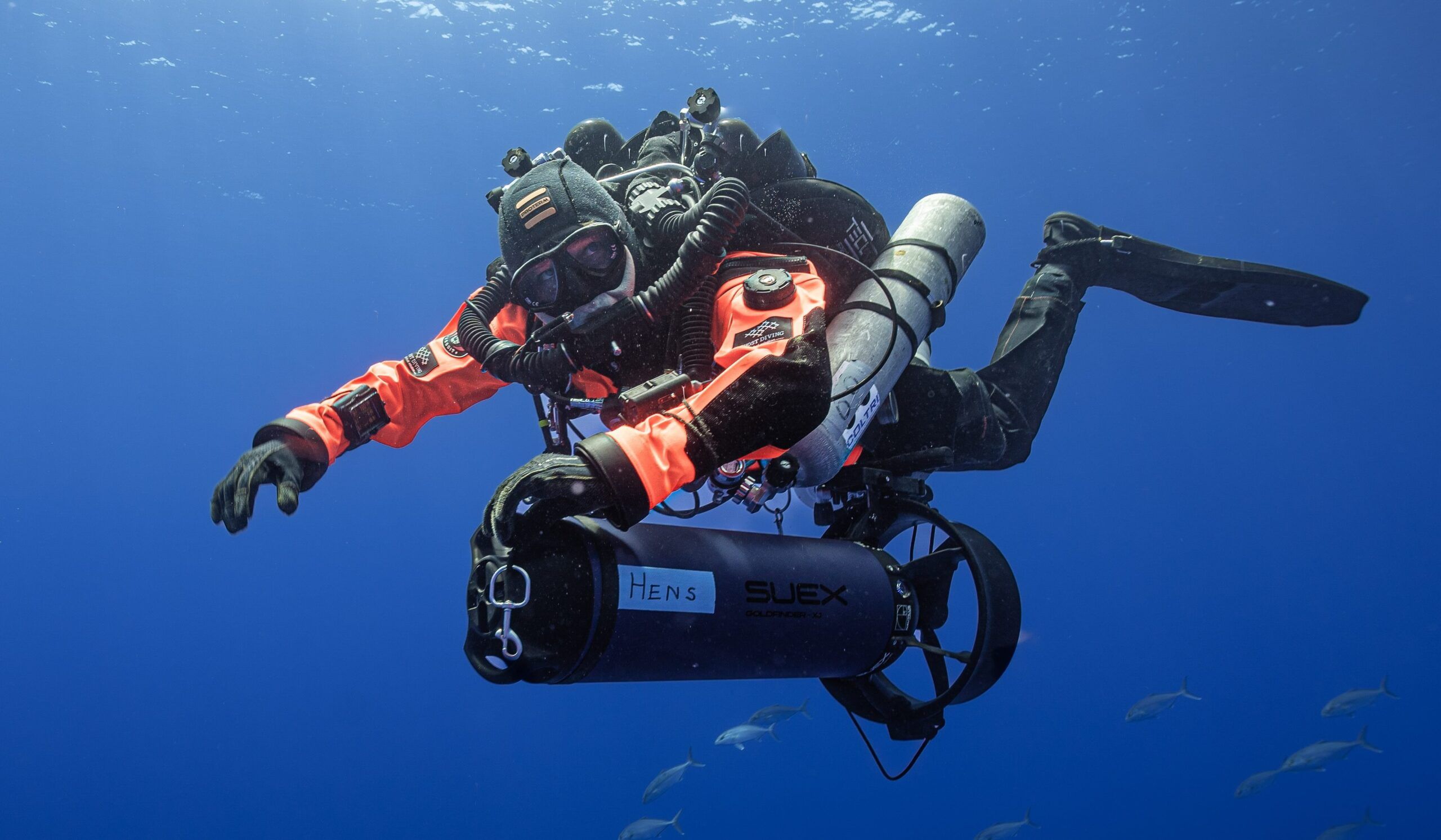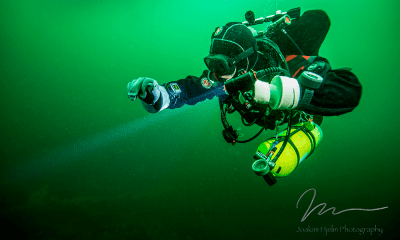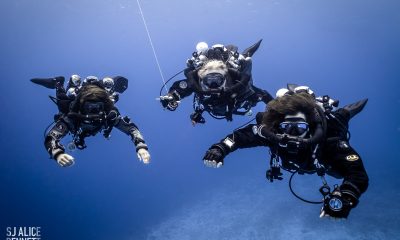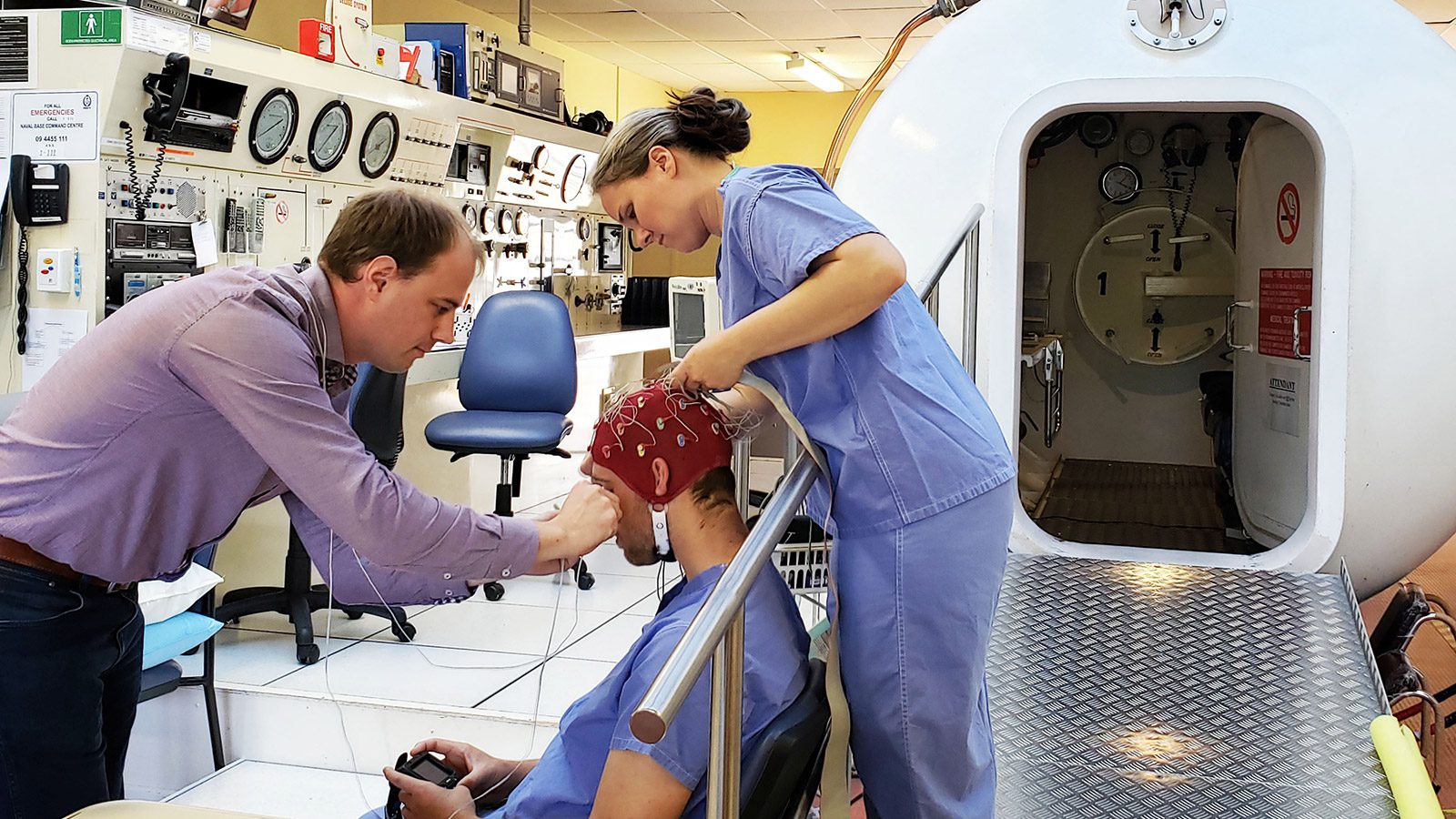
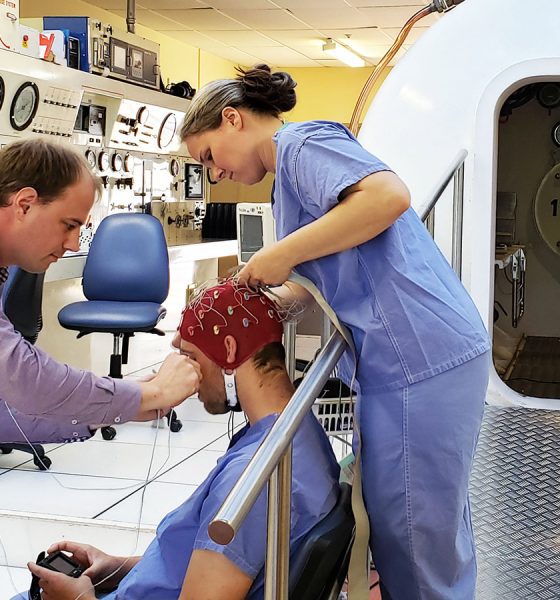
Diving Medicine
Is Oxygen Narcosis A Thing?
There’s been a long running debate as to whether oxygen is a narcotic diving gas. Training agencies CMAS, GUE, PADI and PSAI include O2 in their equivalent narcotic depth (END) calculations. Others like BSAC, IANTD, NAUI and TDI do not. The problem has been reliably measuring gas narcosis. Enter medical researcher and tech instructor Xavier Vrijdag, who has developed a novel EEG algorithm that can detect the subtle effects of gas narcosis on the brain. His results promise to lead to a deeper understanding of gas narcosis. Hint: Nitrox divers can breathe easy; it’s less narcotic than air!
By Xavier Vrijdag PhD. Header image: Drs. Vrijdag and Hanna van Wart preparing participant in front of the hyperbaric chamber. The EEG electrodes are placed inside the cap and two more electrodes are placed under the eyes. Photo by Payal Razdan.
?? Predive Clicklist: Love Is Like Oxygen by Sweet (1978)
? Love is Like Oxygen,
You get too much, you get too high,
Not enough and you’re gonna die.
Love gets you high ?
To sustain life, every breathing gas mixture for divers must include oxygen. As we descend, invariably, we will breathe oxygen at higher partial pressures than air at the surface. Oxygen is mixed with other gasses, like nitrogen and helium, to create suitable mixes for specific depths. One of the boundaries of going deeper is the experience of gas narcosis.
The effects of gas narcosis increase with a diver’s depth because the ambient pressure and the partial pressure of the individual gasses in the breathing mix increase. Gas narcosis has traditionally been linked to nitrogen when breathing air. Narcosis causes behavioral changes and impaired cognitive abilities. Substituting helium wholly or partly for nitrogen ameliorates the narcosis effects. Similarly, it has been argued that replacing some nitrogen with oxygen reduces a gas mixture’s narcotic potency.
One tool to quantify gas narcosis in different breathing mixtures is equivalent narcotic depth (END). In this method, the narcotic effect of a certain breathing gas mixture, like trimix, is compared to breathing air. With the partial pressures for oxygen, nitrogen, and helium in the gas mixture and the intended dive depth, one can calculate the depth at which air would produce a similar narcotic effect. A long-standing debate within the dive industry is whether oxygen should be included in the ‘is narcotic’ or ‘is not narcotic’ portion of this calculation (See: Calculated Confusion: Can O2 Get You High? by Reilly Fogarty)
One of the most used approximations of the narcotic potency of gasses is the Meyer-Overton correlation. The Meyer-Overton correlation describes a relationship between the narcotic potency of a gas and its solubility in oil; the more soluble, the more narcotic. Oxygen has a higher solubility in oil than nitrogen. Therefore one could argue it is more narcotic than nitrogen. However, oxygen is special since we metabolize it.
Nitrogen is a non-metabolic gas, meaning that the inhaled partial pressure of nitrogen equilibrates with the partial pressure of nitrogen in brain tissue after a short wash-in period. In contrast, oxygen is metabolically consumed, thus lowering the partial pressure of oxygen considerably below the inspired pressure. Therefore, despite its greater solubility in oil, one could argue it might be less narcotic than nitrogen.
In addition, exceptions to the Meyer-Overton correlation exist; some gases that are very soluble in oil should be highly narcotic but turn out not to be. In anesthetic research, we have since learned that for a gas to be narcotic, its molecule needs to be able to bind to receptors on the neurons to cause its narcotic effect. Certain molecules have a shape that does not allow them to bind to these receptors. For oxygen, it is unknown if and how it binds to neuronal receptors. The point here is that just because oxygen is more oil-soluble than nitrogen, that does not automatically mean it is more narcotic than nitrogen.

Measurement Methods
Measuring the cognitive effects of nitrogen narcosis is most often done with psychometric tests, like math questions, motor tasks or memory queries. Each of these skills is affected at different partial pressures of nitrogen and is impaired at different depths breathing air. The book, Psychological and Behavioral Aspects of Diving by Nevo and Breitstein summarizes the scientific literature quite well. Higher cognitive functions, like reasoning and memory are impaired in the shallow range (~ 5% at 3 ATA (20 m/66 ft), 30% at 6 ATA (50m/164 ft)).
In contrast, more basic skills like gross motor tasks are only impaired at far higher pressure. Quantification of the subtle effects of inert gas narcosis is challenging. Psychometric tests can be affected by learning effects, participant motivation or boredom. Objective neurophysiological measurements like the critical flicker fusion frequency (CFFF) and quantitative electroencephalogram (qEEG) analysis could, in principle, be used to overcome these issues.
During the CFFF test, the participant looks at a small light oscillating rapidly on and off (flickering). The fusion frequency is obtained by increasing the flicker frequency until the participant perceives a change from flicker to fusion (no further flickering) or the other way around. An increase in CFFF equates to an increase in alertness, whereas a decrease in CFFF is associated with a decrease in alertness, for instance, caused by gas narcosis. Some studies have shown a decrease in CFFF during air-breathing dives at 4 ATA.
Hyperbaric inert gas narcosis is generally considered a manifestation of depressed brain activity when measured with EEG at large depths. Continuous measurement of the EEG results in a considerable amount of data, and analysis is usually performed afterward. This requires much training and time. qEEG has the potential for real-time analysis of the continuous EEG, giving the user an easy-to-interpret result about the narcotic effect. The subtle changes of gas narcosis at typical sport diving depths would otherwise be hard to detect in the EEG. Such analyses would allow comparison between divers and successive dives.
Measuring hyperbaric oxygen and nitrogen’s comparative effects on the brain is difficult. Ideally, the comparison should occur at equivalent inspired pressures of the two gasses. However, nitrogen narcosis symptoms typically present at depths greater than 30m/100 ft (4 ATA); a pressure at which oxygen-breathing would carry the risk of cerebral oxygen toxicity. A pressure of 18 m/60 ft (2.8 ATA) is considered the maximum safe inspired oxygen pressure in hyperbaric oxygen treatments with resting patients in a dry hyperbaric chamber. [WARNING: A PO2 of 2.8 ATA is incompatible with diving!] It follows that the measurement method to detect gas narcosis needs to be sensitive enough to catch the subtle effects of gas narcosis in the more limited and safe inspired pressure range of oxygen.
In a research program funded by the US Navy Office of Naval Research, I studied the subtle narcotic effects of nitrogen and oxygen together with Dr. Hanna van Waart, Professor Jamie Sleigh, and Professor Simon Mitchell.
Measuring The Subtle Effects Of Nitrogen Narcosis
In the nitrogen narcosis study, twelve technical divers breathed air and 21% / 79% oxygen-helium (‘heliox’) at 18 m/60 ft and 50 m/164 ft (2.8 and 6 ATA, respectively) inside a hyperbaric chamber while we recorded the electrical signals of the brain (EEG), performance on a mathematics test and the CFFF. Breathing air at 50m/164 ft (6 ATA) is typically cited as causing sleepiness, euphoria, overconfidence, idea fixation, and impaired reasoning, memory, calculus, and judgment. However, these symptoms may be alleviated by enhanced concentration in motivated divers.
The CFFF did not change during the air-breathing hyperbaric exposure to 6 ATA compared to surface recordings. Hence, the CFFF did not detect the nitrogen narcosis effect at this depth. We also reviewed the CFFF diving literature and found a complicated and often contradictory picture. Various studies during air breathing conducted at 4 ATA have suggested that nitrogen narcosis is the cause of a reduction in CFFF at this depth. However, this result does not extrapolate to greater depth, even though it is known that cognitive performance is further reduced with increased depth. Several studies—including our experiments—performed at 6 ATA while breathing air did not show impairment, but instead showed either no change or an increase in CFFF. Hence, in our study, CFFF failed to detect or quantify a narcotic effect known to be present at 6 ATA.
On the contrary, we successfully developed a quantitative EEG metric to measure narcosis produced by nitrogen at hyperbaric pressures. The functional connectivity metric is based on the so-called mutual information analysis, and was summarized using the global efficiency network measure. Mutual information measures the information that is similar between two signals, calculated between all EEG channels. Higher mutual information means that the signals are more alike.

Global efficiency measures how well connected a network of channels is. High global efficiency based on mutual information means that more signals are similar. Normal cognitive function requires regional specificity, which might be lost (that is, signals become more similar) during impairment.
The novel EEG method successfully differentiated between breathing air at the surface and air at 50m/164 ft (6 ATA) with a 35% increase in the functional connectivity metric. To our surprise, we could even detect a trend of a 19% increase at the much lower pressure of 18 m/60 ft (2.8 ATA). This indicates a dose-response between EEG functional connectivity and nitrogen narcosis. No significant change in the metric was found during the hyperbaric heliox exposures, which was expected because helium is known to be a non-narcotic gas. This lack of an effect of heliox confirmed that nitrogen exposure and not the environmental pressure change was responsible for the changes we saw in EEG functional connectivity.
Another implication of the increased functional connectivity metric during air breathing at 18 m/60 ft (2.8 ATA) is that it should be sensitive enough to measure the narcotic effects of oxygen at 18m/60 ft inside a hyperbaric chamber, if such effects exist. As stated above, we can safely breathe oxygen at 18 m/60 ft inside the safety of a hyperbaric chamber, where there is no risk of drowning, compared to being submerged. If oxygen were to have similar narcotic effects as nitrogen, we expect that functional connectivity would change in a similar way during oxygen exposure as it did in the air-breathing experiment at 18 m/60 ft.
Measuring Oxygen Narcosis
In the oxygen narcosis study, twelve technical divers breathed 100% oxygen at the surface, 4 m/13 ft and 18 m/60 ft (1, 1.4, and 2.8 ATA, respectively) inside a hyperbaric chamber while we recorded the EEG. Four meters/13 ft (1.4 ATA) was chosen as it approximates the upper limit of oxygen exposures accepted in diving, while 18m/60 ft (2.8 ATA) is the maximum exposure to oxygen inside a hyperbaric chamber with a minimal risk of oxygen toxicity.
The EEG functional connectivity metric did not increase while breathing hyperbaric oxygen. This contrasts with the 19% increase we reported above in participants breathing air at 18m/60 ft (2.8 ATA). This suggests that oxygen is not producing the same changes in brain electrical activity seen during hyperbaric air breathing.
It is only now, with the development of this novel EEG analysis algorithm, that we have been able to investigate the subtle effects of hyperbaric oxygen in more detail, and based on our results we hypothesize that oxygen probably does not bind to the same neuronal receptors and hence does not cause similar narcotic effects to those induced by nitrogen. For nitrox divers, this probably means that the increased oxygen slightly reduces the narcotic potency of the breathing gas.
Dive Deeper
OzTek presentation: Measuring gas narcosis in divers
British Journal of Sports Medicine: Towards gas narcosis monitoring in compressed gas diving (PhD Academy Award). (2022)
Scientific Reports: EEG functional connectivity is sensitive for nitrogen narcosis at 608 kPa. (2022)
Physiological Reports: Does hyperbaric oxygen cause narcosis or hyperexcitability? A quantitative EEG analysis. (2022)
Diving and Hyperbaric Medicine Journal: Investigating critical flicker fusion frequency for monitoring gas narcosis in divers. (2020)
InDEPTH: Calculated Confusion: Can O2 Get You High? by Reilly Fogarty (2019)
Alert Diver.Eu: Rapture of the Tech: Depth, Narcosis and Training Agencies by Michael Menduno (2020)
Alert Diver.Eu: Measuring Inert Gas Narcosis by Michael Menduno (2020)

Xavier Vrijdag is a diving medical researcher at the University of Auckland investigating the effects of gas narcosis in divers on the brain. He has a master’s degree in Technical Medicine for the University of Twente, the Netherlands, where he developed an algorithm to quantify cerebral arterial gas embolism in the hyperbaric environment. In 2022, he completed his doctoral thesis on the effects of nitrogen, oxygen, helium and carbon dioxide under pressure.
Xavier has worked as a researcher and technical physician at the department of Diving and Hyperbaric Medicine of the Academic Medical Centre, Amsterdam, the Netherlands. Before coming to New Zealand, he worked as a hyperbaric technician and researcher at Deep Dive Dubai. He is an instructor for medical courses of DAN Europe, holds certifications from seven training agencies, and is an SSI divemaster instructor, normoxic trimix instructor, cave instructor and freediving level 2 instructor, and is a GUE fundamentals instructor.
Besides work, Xavier is an avid cave and wreck diver and photographer, as well as being part of a CaveSAR/LandSAR cave rescue team in New Zealand.



















